ECLIPSE - BAILEY'S BEADS


Near the beginning and end of total solar eclipse, the thin slice of the Sun visible appears broken up into beads of light. These lights are called 'Baily's Beads' after the British astronomer Francis Baily who discovered them. They occur because the edge of the Moon is not smooth but jagged with mountain peaks.
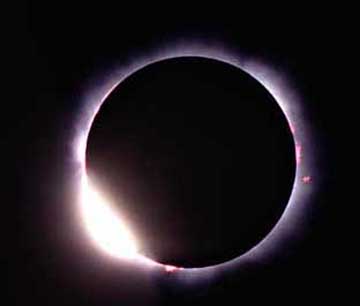

Ancient civilzations used the movement of the heavens as celestial calendars. They created great stone monuments called celestial observatories to this end. To the ancients - an eclipse often represented the Eye of God!
Ancient observations of solar eclipses from many different cultures and civilizations date back to at least 2500 BC in the writings that have survived from ancient China and Babylon. To establish an accurate luni-solar calendar, people in ancient civilizations observed the moon regularly. Lunar eclipses were the first major celestial events that astrologers learned how to predict based on local historical observation records.
One of the first things civilizations must do to ensure a coherant society is to establish an accurate calendar to organize planting and harvesting of crops. Most early calendars were lunar calendars, because the monthly duration of the lunar cycle is 29.53 days, 12.37 months during a solar seasonal year. Every year, the lunar "synodic" calendar of 29.53 days slips by 0.38 of a month or 11.2 days relative to the seasonal "planting" year.
At the same time that ancient peoples kept track of how the lunar and solar calenders meshed with each other, they also uncovered some of the factors that lead to lunar and solar eclipses which also require specific timings of the solar and lunar positions across the sky and over the years. In many ways, the ability to predict eclipses was an outgrowth of the pre-existing need to keep track of lunar and solar calender relationships.
Ancient China - By 2300 BC, ancient Chinese astrologers, already had sophisticated observatory buildings, and as early as 2650 BC, Li Shu was writing about astronomy. Observing total solar eclipses was a major element of forecasting the future health and successes of the Emperor, and astrologers were left with the onerous task of trying to anticipate when these events might occur. Failure to get the prediction right, in at least one recorded case in 2300 BC resulted in the beheading of two astrologers. Because the pattern of total solar eclipses is erratic in any specific geographic location, many astrologers no doubt lost their heads. By about 20 BC, surviving documents show that Chinese astrologers understood what caused eclipses, and by 8 BC some predictions of total solar eclipse were made using the 135-month recurrence period. By AD 206 Chinese astrologers could predict solar eclipses by analyzing the Moon's motion.
Ancient Chinese astronomy was primarily a government activity. It was the astronomer's role to keep track of the solar, lunar, and planetary motions as well as divine what astronomical phenomena may mean for the ruling emperor. Solar eclipses, infrequent and dramatic, were important enough to be recorded in chronicles and on "oracle" bones. Below are a few translated eclipse records found in the documents of ancient China from various dynasties. In general, the translations give the Roman calendar dating of the event, the Chinese dating, and the observation. Following in parentheses is the record in which the observation is noted. More translated records can be found in the references given below. Unless otherwise noted, the translations below can be found in the book Historical Eclipses and Earth's Rotation by F. Richard Stephenson.
"Oracle" bones are pieces of animal bones and tortoise shells inscribed with astronomical observations, that were probably used for divinations. Oracle bones hail from the Shang dynasty (c. 1600 - 1050 BC) and make many references to solar eclipses. The eclipse records are often incomplete, however, and the dating of the bones is not reliable.
Eclipse observations from the Chou dynasty and Warring States period (c. 1050-221 BC), and onward, have been reliably dated, and it appears that some astronomers recognized eclipses as naturally occurring phenomena. From the Chou dynasty, 36 solar eclipse observations are recorded in the Ch'un-ch'iu beginning around 720 BC. The Piao and the Shih-chi documents refer to nine solar eclipses from the Warring States period.
Records of solar eclipses from the Han dynasty (206 BC - 220 AD) are found primarily in two official histories: the Han-shu and the Hou-han-shu. There are no records of eclipses from the Ch-in dynasty which came just prior to the Han dynasty (221 BC - 206 BC).
During the Ming dynasty (1368-1644 AD), total solar eclipse observations are found in the histories of Ming provinces after 1500 AD. Prior to 1500 AD, eclipse records can be found in the Imperial Annals. These observations, however, are not of total solar eclipses. Aug 20, 1514 AD: "At the hour of wu suddenly the Sun was eclipsed; it was total. Stars were seen and it was dark. Objects could not be discerned at arm's length. The domestic animals were alarmed and people were terrified. After one (double-)hour it became light." (local history of Tung-hsiang county, Chiang-his province)
Accurate eclipse timings can be used to determine the rate of the Earth's rotation. According to Steele and Stephenson, solar eclipse timings can be found from the periods between 600 and 800 AD, 1000 and 1300 AD, and a brief period during the Ming dynasty. These solar eclipse timings are accurate to about 0.4 hours.
-
Babylon and Sumer and Babylonian clay tablets that have survived since dawn of civilization in the Mesopotamian region record the earliest total solar eclipse seen in Ugarit on May 3, 1375 BC.
Like the Chinese, Babylonian astrologers kept careful records about celestial happenings including the motions of Mercury, Venus, the Sun, and the Moon on tablets dating from 1700 to 1681 BC. Later records identified a total solar eclipse on July 31, 1063 BC, that "turned day into night," and the famous eclipse of June 15, 763 BC, recorded by Assyrian observers in Nineveh. Babylonian astronomers are credited with having discovered the 223-month period for lunar eclipses.
At this time, the same lunar phase would be recorded at the same time of the solar calendar year. This period also gives a rough guide to when a lunar eclipse will recur at the same geographic location. Ptolemy (ca 150 AD) represents the epitome of knowledge of Grecian astronomy. Records such as the Almagest show he had a sophisticated scheme for predicting both lunar and solar eclipses. Ptolemy knew, for example, the details of the orbit of the Moon including its nodal points. He also knew that the Sun must be within 20 degrees 41' of the node point, and that up to two solar eclipses could occur within seven months in the same part of the world. Lunar eclipses were especially easy to calculate because of the vast area covered by Earth's shadow on the Moon. Solar eclipses however required much greater knowledge. The shadow of the Moon on Earth is less than 100 kilometers wide, and its track across the daytime hemisphere is the result of many complex factors that cannot be anticipated without a nearly complete understanding of the lunar orbit and speed.
-
Ancient India - Indian astronomy is largely wrapped up in the Vedic religious treatises, but one individual, Aryabhata of Kusumapura, born in AD 476 is noteworthy. He is the first known astronomer on that continent to have used a continuous system of counting solar days. His book, the "Aryabhatiya," published in 498 AD described numerical and geometric rules for eclipse calculations. Indian astronomy at that time was taking much of its lead from cyclic Hindu cosmology in which nature operted in cycles, setting the stage for searching for numerical patterns in the expected time frames for eclipses.
-
The ancient Mayans - While Chinese, Babylonian, and Greek astronomers dominated the knowledge of old world astronomy half way across the globe, Mayan observers were working on calendars and recording celestial observations. The Dresden Codex records several tables thought to be lunar eclipse tables. As in previous civilizations in other parts of the world, the Mayas used records of historical lunar eclipses to calculate how often they occurred over a 405-month period. There is no mention of recorded total solar eclipses, or discussions in the Codex for how to predict these events. After the Spanish Conquistadores, came the missionaries in the 1600s who intentionally destroyed nearly all native written record. Little survives to tell us whether the Mayas, Incas, or Aztecs achieved a deeper understanding of solar eclipses and their forecasting.
Mayan astronomers were well aware that small cycles lead inevitably to bigger ones. Their codex seems to have been a mechanism for predicting not when the first crescent moons of the future could be sighted, but which full moons would be eclipsed and which new moons would eclipse the sun. It must have taken all of a century or more, which means several generations of perceptive astronomical observing, for specialists in skywatching to work through to a conclusion that their Chinese and Babylonian counterparts also had arrived at, i.e. that once a lunar or solar eclipse occurs, it is not possible to have another ( of the same kind) until six, or more rarely, five months pass.
Of the long-range Moon cycle in the Dresden Codex, this much is certain: First, it was used to gain control of astronomical time; and second, it was a time cycle derived from the observation of eclipsed and uneclipsed moons of the past, which could be used as data to generate a model for anticipating the occurrence of future lunar eclipses powerful knowledge in the hands of the rulership.
Is the Dresden Codex a record of eclipses in part intended to warn of possible future eclipses? And, if so, what kind of eclipses? There seems little doubt that the Mayas sought to predict eclipses because of the disaster that they believed threatened them on such occasions. The omens in the table look ominous enough, at least to us. Of course, predictions must be based upon recorded observations of actual eclipses that occurred in Yucatan when the Mayan priests did their work. Though scholars are not in agreement over which particular set of eclipses (lunar or solar) was being observed, there is enough evidence to support the hypothesis that the Dresden Eclipse Table was devised for warning of the possible occurrence of such phenomena.
Both lunar and solar observational eclipse data can be utilized to construct a semblance of the Dresden Table. The hypothesis that lunar data were actually used seems much simpler. In the course of the thirty-three years spanned by the table, the number of such eclipses observable in Yucatan would have been significant enough to enable a single priest to draw up the table. If we assume that solar eclipses alone were used, and this certainly cannot be ruled out, we must extrapolate the base of observations backward many centuries in order to derive the relevant intervals.
The eight pages of the Moon table of the Dresden Codex are a chain of numbers across the bottom line of each page translates into a time packet of lunar synodic intervals. There are clumpings of six lunar synodic months (178 days) followed by one set of five (148 days). Each bunch of five moons is followed by a picture. A close look at all of the pictures together gives very strong clues about what the Mayas would do, parcel out a chain of 405 full moons over more than three decades. The answer is that Mayan astronomers were attempting, apparently quite successfully, to predict eclipses. Some of these illustrations depict half-light, half-dark disks with lunar crescents opposing the kin glyph, symbol of the Sun ( kin means sun and day as well as time in the Mayan language). A serpent devouring the Sun and a dead lunar goddess hanging by her hair from a segmented serpent who represents the sky also appear in the pictorial portion of the table.
-
The Islamic World - Islamic astronomy became the western world's powerhouse of scientific research during the 9th and 10th centuries AD, while the Dark Ages engulfed much of the rest of the western world. The works by Ptolemy, Plato, and Aristotle were translated, amplified upon and spread throughout the Muslim world. Al-Khwarazmi developed the first tables trigonometric functions (ca 825 AD) which remained the standard reference well into the modern era. Al-Khwarazmi was known to the west as "Algorizm" and this is, in fact, the origin of the term 'algorithm'. Al-Khwarazmi's calculations were good to five places, allowing for unprecedented precision in astronomy and other sciences. At Antioch, Muhammad al-Batani (ca 850 AD) began with Ptolemy's works and recalculated the precession of the equinoxes, and produced new, more precise astronomical tables. Following a steady series of advances in Islamic trigonometry, observations by Ibn Yunus of lunar and solar eclipses were recorded in Cairo ca 1000 AD. Ibn Yunus is regarded as one of the greatest observational astronomers of his time. The pace of Islamic science and scholarship eventually slowed down in the 11th and 12th centuries. Many great books and great ideas of the Islamic Age lay fallow for hundreds of years until they were finally translated into Latin and fueled the European revolution in thinking and the birth of science as we know it today.
The European appetite for books was no doubt stimulated by the cutting edge technology of that time: the printing press. This period was called the "Renaissance" (ca1500 AD) signifying the rapid growth of fresh perspectives and ideas. Many of these books were scientific, technical, and mathematical works, most of which had been gathered or written by scientists during the Islamic Renaissance that peaked some 600 years before Europe's! Islamic rulers sponsored the systematic collection and translation of scholarly books from every culture they came across.
For nearly two centuries, a diverse group Islamic thinkers (concentrating in Iran and the Middle East, but extending from Spain and North Africa to India and the Far East) amplified, elaborated, and extended the libraries of scientific knowledge that they had collected. They made great advances in math and science, observed nature and human society, amassed discoveries and inventions during the flowering of Islamic culture. The decline of Islamic learning had begun by the 11th century. By the 13th and 14th centuries, European translations of the volumes of Islamic theology, science, and technology had laid a rich foundation for the birth of modern science. Much of the library of Islamic sciences remains in Arabic to this day.
-
Ancient Greece - By 450 BC, the Greek civilization was in its ascendancy. The historian Herodotus (ca 460 BC) mentions that Thales was able to predict the year when a total solar eclipse would occur. Details of how this prediction was made do not survive. The eclipse occurred in either 610 BC or 585 BC. Apparently the method used worked only once because what is known of Greek scientific history does not suggest that the method was ever reliably used again. Thales is said to have visited Egypt, and from the empirical rules in use there for land surveying, brought back to Greece the ideas of deductive geometry later codified by Euclid. Before 450 BC, Meton realized that a single period of 235 lunar months (19 years) would cause the popular lunar calendar to return to synchrony with the solar, seasonal calendar.
-
Ancient Egypt - Nearly all we know about ancient Egyptian civilization's knowledge of astronomy comes to us from tomb paintings, various temple inscriptions, and a handful of papyrus documents such as the Rhind Papyrus. Unfortunately, the Great Library in Alexandria was burned during the time of Cleopatra and Julius Caesar. Later burnings in AD 390 and AD 640 destroyed an estimated 400,000 books on Egyptian secular literature, mathematics, medicine, and astronomy. The burnings were classified as one of the greatest intellectual catastrophies in human history. One can only guess what Egyptian knowledge of astronomy was lost. All that survives is fragments that some scholars see as merely the faded ghosts of Egyptian intellectual legacy.
The oldest example of a sundial is Egyptian from about 1500 BC. The fabulous astrological ceiling of Senmut painted around 1460 BC, includes celestial objects such as Orion, Sirius, and the planets Mercury, Venus, Jupiter, and Saturn. The oldest known copies of an almanac date from 1220 BC at the time of Ramses the Great. In 1100 BC Amenhope wrote "Catalog of the Universe" in which he identified the major known constellations. Curiously, the catalog does not mention either Sirius or any of the planets previously known to the Egyptians. At least outwardly, there are no surviving inscriptions or documents to indicate that Eqyptian knowledge of astronomy was more than tomb decoration, and not protected over the ages as a body of knowledge. Numerous temple and pyramid alignments and several papyrus codices suggest a sophisticated knowledge of trigonometry and algebra; no similar astronomy documents survive, or records of astrological observations. The Vienna papyrus which described lunar and solar eclipses and their portent was probably copied by a scribe in the late second century AD, and presents knowledge of astronomy that is regarded as Babylonian in nature.
A full discussion of the presumed knowledge of solar eclipses by the ancient Egyptians is beyond the scope of these brief comments. However, it is pertinent to note that Greek writers, without exception, gave priority to Egypt in astronomical knowledge. Still, there has not yet come to light an Egyptian document specifically mentioning solar eclipses. However, that the Egyptians possessed accurate knowledge of eclipses is evident from external sources.
Diodorus Siculus (200 A.D.), stated categorically that the ancient Egyptian astronomers possessed the ability to predict solar eclipses. Plutarch related that the ancient Egyptians explained solar eclipses by the passage of the Moon between the Sun and the earth in daylight hours. There is evidence, admittedly disputed by some writers, that an actual solar eclipse was reported in Egypt in the 9th century B.C. and again in 610 B.C. The report of this latter eclipse has been attributed to Thales, though others, e.g., Herodotus, claim that Thales actually predicted an eclipse in 584 B.C. Thales, Greece's first "philosopher", was actually of Phoenician birth and spent seven years studying in Egypt. Greek commentators attribute Thale's mathematical and astronomical knowledge to this apprenticeship in Egypt.
The golden age of Greek science commences with the Ptolemaic dynasty (330 B.C.) in Egypt, the building of Alexandria, and the founding of the city's Library. The major Greek astronomers studied there. Moreover, several of the Alexandrian astronomers considered Greek were actually Egyptians who had adopted or been given Greek names. One such person was Ptolemy (150 A.D.), author of the Almagest, the most important astronomical text until the Middle Ages, whose knowledge of solar eclipses is well-documented.
Clement of Alexandria (2nd century A.D.), author of Stromateis described 49 books of Thoth preserved by the priests of ancient Egypt - at least four of them treating astronomical subjects. One book dealt with the "constitution of the Sun and Moon" and another "the conjunctions and variations of the light of the Sun and Moon." That the ancient astronomer-priests of Egypt could and did predict eclipses was considered axiomatic. Information detailing Egyptian priesthood repeatedly confirm the remarkable ability of that priesthood to predict solar eclipses.
- The Sun god Atum is the eclipsed Sun passing the second contact of a total eclipse.
- Ra/Re is the eclipsed Sun shining past the third contact as the Diamond Ring effect.
- The Scarab Khepri was a representation of the dark New Moon.
- The Hawk Horakhty - Horus - is the Sun through totality.
- The Great Sphinx was the Egyptian 'Lord of Solar Eclipses'.
- Hathor was the Egyptian goddess of solar eclipses.
- The God Aten of the Amarna Revolution is the shadow bands phenomenon.
- Reference - Dreyer, J.L. E., A History of Astronomy from Thales to Kepler
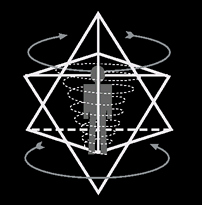
The diamond shape symbolizes the star tetrahedron - part of sacred geometry - the mathematical patterns that create our reality. Consciousness spirals from one level of awareness to another.
This pattern links with creation - the Star of David - Flower of Life - Qabbalah and Merkabah.
From the Egyptian Pyramid Texts: "The eclipse represents the breaking of the Egg and Splitting the Iron." The iron is the rod - the magnetic poles - north/south - duality of experience creates by electromagnetic energy - the aura - needed to create a physical reality and the illusion of linear time. The Two 'Diamond Ring Effects' crowned the eclipsed shadow on the head of Re.
As is above, So is below - Emerald Tabets of Thoth - Hermes Trismegistus
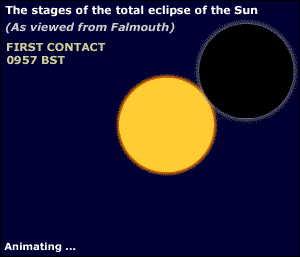
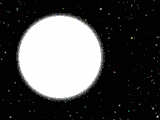
The Merge of Matter and Antimatter

Polarites - Sun / Moon - Balance
Beads are a metaphor for DNA.

The Monolith from the Movie '2001' - Thus Spake Zarathrustra - Zoroaster
Kubrick's masterpiece, 2001 refers to the heart of the Isis/Osiris mystery. The obelisk is the male aspect, the generative force. The dome refers to the female aspect, and the result is of course the Dawn, the synthesis of Isis and Osiris, who is Horus the Star Child! The Star Child at the end of 2001 is Horus, the New Man, Aquarius. Monoliths and Messages
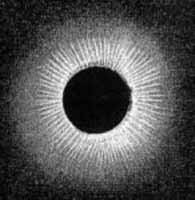
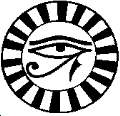
Eye of Horus - 12X 3= 36 around 1
Bailey's Beads - Spiraling Identical Twin Strands of DNA -
Number 11
Events of 911
Evolution of consciousness
ELLIE'S ARCHIVES AND ADVENTURES
ALPHABETICAL INDEX OF ALL FILES